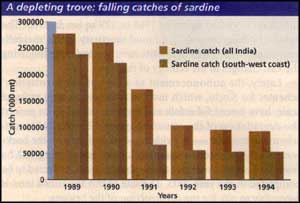No longer packed...
 THE oil sardine (Sardinella longiceps) a brilliantly coloured fish dear to the palate of Keralites and once the poor man's cheap source of protein has become scarce. One sardine today costs Rs 3.00; two decades ago a single rupee bought 100 sardines. Over-exploitation and environmental pollution have reduced the total fish catch from 2.8 lakh mt (metric tonnes) in 1989 to 0.95 lakh mt in 1993. Along the Kerala coast the landings of oil sardine was 2.5 lakh mt in 1968. Now it is about 0.5-lakh tonnes (t).
THE oil sardine (Sardinella longiceps) a brilliantly coloured fish dear to the palate of Keralites and once the poor man's cheap source of protein has become scarce. One sardine today costs Rs 3.00; two decades ago a single rupee bought 100 sardines. Over-exploitation and environmental pollution have reduced the total fish catch from 2.8 lakh mt (metric tonnes) in 1989 to 0.95 lakh mt in 1993. Along the Kerala coast the landings of oil sardine was 2.5 lakh mt in 1968. Now it is about 0.5-lakh tonnes (t).
The oil sardine is distributed throughout the Arabian Sea from the Gulf of Aden to the West Bengal coast. But 75 percent of all oil sardine landings are from the Indian coast. In 1964 the oil sardine accounted for 32 per cent of total marine fish landings; but in 1993 this came down to 4.2 per cent.
During the early part of this century the demand for fish oil in Europe and elsewhere had given an impetus to the sardine oil industry and its trade. Even in those days Francis Daythe famous ichthyologist, warned that "it must be left to future years to demonstrate whether the present increase in fish oil trade due to high prices is a healthy or unhealthy stimulus; if the latter, the fisheries are being overworked and the future loss will be great".
In spite of the warning the early '20s saw a rapid boom in the oil sardine trade and industry. But this was followed by the collapse of fisheries in the late '30s and early '40s resulting in the closure of sardine oil factories never to be revived again.
Conservation measures were introduced in 1943 and included legislations banning capture of juveniles and spawners. The highly destructive boat seines (a type of net) and the gillnet were also banned. But the legislation lapsed in 1946 due to difficulties in implementation. Fishery research is now undertaken by the Central Marine Fisheries Research Institute (Kochi).
Catch analyses of oil sardines clearly indicate that one of the main reasons for the steep fall in oil sardine catches is over-exploitation. In Kerala itself, there are about 1,000 trawlers 500 outboard engine-fitted plank-built boats 300 mechanised catamarans about 5,000 plank-built non-mechanised boats 10,000 dugout canoes and 12,000 catamarans. Besides there are 1,500 trawl nets 24,000 gillnets and driftnets 1,000 boat seines, hundreds of ring nets and disco nets. Nets like the nylon ring nets and disco nets are capable of 'efficiently' depleting entire shoals of fish within a short time. Such nets are especially deadly in shallow water sand the fad that the oil sardine shoals are not very large aggravates that danger to them. These nationalised banks also contribute to the' depletion of the fish stock by advancing enormous amounts as soft loans to such lethal' fishing units.
The fisherfolk blame the outboard engines and the noise they produce which is magnified underwater for driving away oil sardine shoals. The fisherfolk fear that the oil sardines have migrated to the east coast. But this is untenable as collections made more or less at the same time of oil sardines of all size groups have shown themselves to be similar along both the eastern and western coasts. Further oil sardines do not migrate over such long distances. This serves to emphasise that failure to conserve our fish resources and harvest the fishes in a sustainable manner will result in irreversible degradation. And the responsibility for this will be shared by all scientists, research institutes, government politicians and the fisherfolk alike.
R S Lalmohan is a Calicut-based marine scientist
